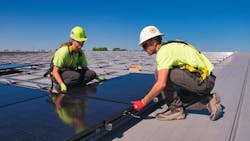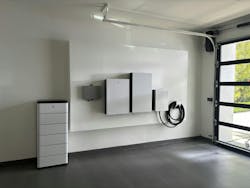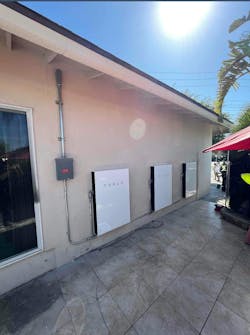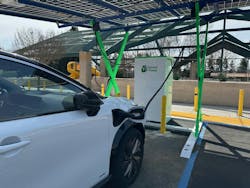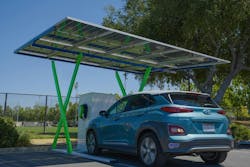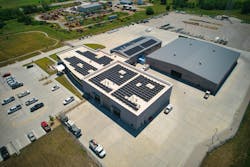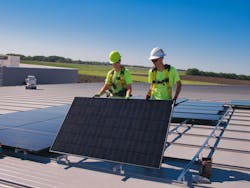Electrifying the EV Charging Market with Solar and Storage Integration
Key Takeaways
- The EV charging market is expanding rapidly, with over 17 million EVs sold globally and significant growth in the U.S., creating opportunities for electrical contractors to diversify their services.
- Integrating renewable energy, storage, and EV charging can reduce demand charges, improve resilience, and enable customers to maximize the use of clean energy sources, especially with home solar systems.
- Successful market entry requires thorough planning, understanding of local regulations, and the ability to design scalable, future-proof systems that combine multiple energy components seamlessly.
As the demand for electric vehicles (EVs) worldwide continues to rise, electrical contractors are plugging into a new business opportunity in the EV charging market. Today, EV sales in the United States have increased to 1.6 million, and globally, to more than 17 million, according to IEA’s 2025 Global EV Charging Outlook.
For example, Trout Electric, a Riverside, Calif.-based electrical contractor, opened its doors in 2008 and dove into the EV charging installation market three years later. Electrification now accounts for 80% of its business between residential and commercial markets.
“Once we saw the potential for the EV market, we fully invested in it,” said Matt Trout, president of Trout Electric, which has four offices in Southern California and Nevada. “We made sure we were on top of all new products and trained our technicians to the fullest extent possible.”
As the EV charging market continues to heat up, contractors are also exploring how to integrate EV charging with on-site renewable energy and storage. With this approach, they can help their customers to reduce demand charges, improve resilience, and support sustainability goals.
“We’re starting to see more customers realize that investing in a combined system delivers greater value than the sum of its parts,” said Kristina Zagame, senior researcher, Electrification, for EnergySage, which connects certified, pre-screened installers with homeowners. “They’re not just saving on energy bills; they’re creating an efficient and resilient energy system for their property and vehicles.”
Case in point: Charging an EV at home is three times less expensive compared to using a DC fast charger — and, with home solar, that cost can drop to virtually zero, she said.
“While it’s not universal yet, adoption is growing, especially in states like California and Texas,” Zagame said. “We expect more homeowners and businesses to start connecting these technologies as they look for ways to save money, reduce reliance on utilities, and improve resilience.”
Embracing opportunities
Systems that integrate EV charging, storage, and solar are still emerging, but the market is growing rapidly, said Tom McCalmont, co-founder and CEO of Paired Power, which specializes in solar microgrid charging systems for EVs and EV fleets. In fact, analyst reports predict that the market for integrated chargers will nearly double from 2021 to 2031, he said.
“Outside of a major expansion of the U.S. grid, integrating solar, battery energy storage systems, and EV charging is the most realistic way to expand EV charging infrastructure to meet demand,” said McCalmont, who co-founded the solar engineering firm McCalmont Engineering, and has 25 years of solar, storage, and EV charging experience. “With the push for transportation electrification combined with data center growth due to AI, there is huge demand for grid expansion that our integrated solar and EV charging system can mitigate.”
An integrated EV charging system can ensure that grid power is managed to reduce or eliminate demand spikes during the day, can time-shift solar power to offset peak time energy costs, or can bank solar power during the day for charging vehicles at night, he said. The storage and solar components of the system can also act semi-independently of the grid, providing a resilient energy source during blackouts or brownouts.
Electrical contractors who understand renewables and EV charging can embrace a huge opportunity, Zagame said.
“This isn’t just wiring a new outlet — it’s knowing when a panel upgrade is needed, how to balance loads when you’re adding multiple systems, and how to properly design for future additions like a battery or more solar,” she said.
For example, the recently released “Marketplace Report” from EnergySage shows solar contractors are already moving into whole-home electrification services, with storage installed alongside 33% of solar projects, energy monitoring systems with 25%, and panel upgrades with 11%. But adding other electrification products at the same time as solar (like EV chargers and heat pumps) is still minimal, even though they represent a massive market opportunity, she said.
“Contractors that expand beyond single-trade solar or EV charging into full-home electrification can build multiple revenue streams, form stronger customer relationships, and better position themselves as the industry evolves,” she said. “The electrical contractors who invest in this expertise now will capture the largest share of this growing market and be resilient to future changes.”
While some consumers may think they must buy everything at once, they can start with solar, add an EV charger later, and then install a battery when it makes sense.
“It’s typically easier and cheaper to install all at once, but as long as the system is designed to be expandable, you can move toward full electrification step by step,” she said.
Looking ahead, she said these technologies won’t be treated as separate, either in how contractors build their businesses or what consumers expect.
“We’re moving toward a future where a typical home will have solar, storage, and EV charging designed to work together from day one, with smart controls that optimize energy use,” she said. “On the commercial side, the same integration will help businesses cut operational costs and meet sustainability goals. Integration isn’t a nice-to-have anymore; it’s quickly becoming the standard.”
Reducing charges
When solar, storage, and charging are integrated, customers can significantly lower demand charges using battery storage to flatten their peak electrical draw from the grid. Integrated systems can charge batteries during off-peak hours and discharge them when EV charging would spike grid consumption.
“Instead of solar power flowing back to the grid during the day and then drawing grid power to charge EVs at night, integrated systems store that clean energy and use it directly,” she said. “For many customers, this creates a closed loop where their transportation and home energy needs are met almost entirely by renewable sources.”
When EV chargers are paired with storage and solar, they create microgrids that can keep critical loads running during outages, said Malcolm Proudfit, CEO of Good Energy Solutions in Lawrence, Kan.
“For businesses, this translates to uninterrupted operations and reduced risk exposure,” Proudfit said.
Getting into the market
Proudfit said the expertise to deliver seamless solutions for EV chargers, solar, and battery storage has been refined over time at Good Energy Solutions, which has licensed electricians on staff. The company also employs six team members with credentials from the North American Board of Certified Energy Practitioners (NABCEP) with certifications for solar installation, battery storage, and solar system inspection.
“As solar installers, we already understand inverters, site assessment, and electrical integration, which makes EV charger installation and battery storage a logical extension of our services,” Proudfit said. “As more EVs hit the road and the grid becomes more expensive and volatile, we expect to see more demand in the coming years for projects that incorporate EV chargers, solar, and batteries.”
To break into the business, Trout Electric partnered with auto manufacturers and became part of a certified electrician network for a California-based EV charging company. These collaborations helped the company to not only offer EV charging but also renewable energy and battery storage capabilities.
“The electrification market was a natural progression into our clientele as they were the early adopters of renewable energy,” Trout said. “Our early customers were intrigued with battery storage and bi-directional capabilities, and we were able to guide them into systems that worked well for them.”
As of September 2025, Trout Electric has installed more than 25,000 EV chargers in the residential and commercial market, more than 1,000 energy storage systems, and hundreds of bi-directional systems. As far as the utility-scale installations, Trout Electric is also bringing in new power for Level 3 DC fast chargers in the commercial industry.
“As a contractor, we are now bidding a project on solutions rather than the lowest bid mentality,” he said. “This ends up working out well for the consumer and the contractor.”
Overcoming challenges
As with any segment in the energy industry, the solar + storage + EV charging market is not without its obstacles. For example, key challenges include issues with product integration and the lack of standardization between jurisdictions and utilities, which makes it hard to scale, Trout said.
Depending on location, overlapping state and local regulations can also make adhering to code a challenge, McMalmont said. In addition, for contractors and installers, site conditions can vary widely from one charger to another, and it’s not uncommon to see EV charging sites with outdated or antiquated electrical infrastructure, requiring major upgrades.
These types of projects can also be very complex, and, in her experience, Zagame said the more components you add to a project, the more complicated it becomes.
“By themselves, just designing a solar system or a battery backup system comes with a laundry list of challenges,” Zagame said. “Making all three systems work together, especially when using equipment from different manufacturers, takes a great deal of planning, understanding of the technology involved, and a deep knowledge of local building compliance.”
One of the challenges is making sure all these systems work together smoothly and planning for the homeowners’ potential future usage needed to gauge an appropriate system plan, she said.
“The flip side is that this creates a big opportunity,” Zagame said. “The companies that figure out how to deliver a seamless, integrated solution will stand out with customers who want reliability and control over their energy.”
Sharing best practices
When working on the integration of the systems, careful planning is the first step, Trout said. He said his biggest piece of advice to other contractors looking to get into this market is to have an extremely well-thought-out-plan before starting and always think ahead.
“Do not cut corners, do research on all products, and make sure your exclusions are extensive, as many unexpected fees do arise when it comes to planning,” he said.
Proudfit said for those thinking about stepping into integrated solar + storage + EV charging, they should treat it less like “installing equipment” and more like building energy ecosystems. For example, the first issues to tackle involve load modeling, utility interconnection rules, and energy management software.
“That’s where most failures (and profit leaks) occur,” Proudfit said. “It’s important to position yourself not just as a contractor, but also as an energy consultant and integrator, because clients don’t want three separate vendors. They want one partner who can design, commission, and maintain a cohesive system.”
Since Good Energy Solutions began installing solar in 2007, the company has constantly worked toward providing its clients with services that encompass all phases of the life of an energy project.
“These projects are complicated already,” Proudfit said. “Having a partner with intimate knowledge of every aspect of your energy project will make the process of design, installation, and maintenance much easier for companies.”
Another important consideration is code compliance. Electrical contractors need to be able to build microgrid EV charging systems according to National Fire Protection Association (NFPA) guidelines and local AHJ regulations, said Donny Kludt, project executive at Dynalectric San Diego, which provides solar power and renewable energy services.
“One of the most important things that electricians are doing with installing microgrid EV charging systems is ensuring fire safety,” Kludt said. “It is up to these professionals to ensure that energy storage systems comply with fire codes and standards and can pass all scrutiny from fire marshals and local fire departments.”
Looking to the future
While the EV market is charging ahead, the federal solar tax credit is due to expire at the end of 2025. For commercial projects, Ary said the 30% federal tax credit is integral to the wide adoption of projects incorporating EV chargers, solar, and batteries. Even without the tax credits, however, he expects the increased cost of wholesale electricity to drive more demand for these types of projects as companies search for ways to lower their energy costs.
“We expect demand to rise for commercial solar over the next few years as more large data centers pull more energy from the grid, increasing the cost of electricity for everyone,” Proudfit said.
As wholesale electric prices continue to rise over the next decade, more companies will seek out energy solutions to reduce their monthly bills. For example, Good Energy Solutions worked with Evergy to design and install solar/battery/EV charging on its two new service centers in Emporia and Salina, Kan., this year.
“We expect more public facilities, like fire stations or municipal buildings, to adopt integrated solar + EV charging + storage as infrastructure and electrification needs converge,” Proudfit said.
In the future, Trout forecasts the strategy to shift more into power purchase agreements or lease models.
“I personally think that it may slow the industry down for a bit, but as utility costs continue to rise, it will gain traction quickly again,” he said. “The demand for backup power will also continue to rise as our grid ages. I think that companies that continue to do good, quality work will always be in demand.”
Integrating Systems: Step by Step
Before kicking off a project integrating EV charging, solar, and storage, planning is critical, said Matt Trout, president of Trout Electric in California. Here are six steps to keep in mind during a project.
- Understand the main service capability.
- Determine the load calculation.
- Estimate how much renewable energy you will need.
- Decide on a kind of backup capability.
- Make sure everything is done to code following the installation.
- Understand what maintenance is needed for each product installed, as different products require different maintenance intervals.
Lessons Learned with Solar, Storage, and EV Charging Installations
- Planning matters, and it pays off. “If homeowners or business owners know they’ll eventually want solar, storage, and EV charging, it’s often cheaper and easier to tackle the electrical work, permitting, and installation in one shot,” said Kristina Zagame, senior researcher, Electrification, for EnergySage.
- Consider home efficiency upgrades like better insulation and high-efficiency HVAC. “They can dramatically lower your overall energy needs, so you can size your solar and storage systems smaller (and spend less money) while still meeting your goals,” she said.
- Understand the importance of proper load management. For example, smart EV chargers that communicate with solar inverters and battery systems help optimize when vehicles charge, using excess solar during the day and avoiding peak utility rates. “The customers who see the best results are those who think of these technologies as an integrated energy system rather than separate products under the same roof,” she said.
How to Break into the Market
Electricians are crucial to the entire process of installing and integrating EV chargers, serving as the primary professionals responsible for the technical and safety-critical aspects of the job.
“Whether it be performing an initial assessment of the existing electrical system, wiring and circuit installation, testing, or maintaining the systems in working order, electrical contractors are there every step of the way,” said Tom McMalmot, CEO of Paired Power.
Electricians who are working in this sector must be familiar with the National Electrical Code (NEC) as well as local building and electrical codes, which have specific provisions for EV chargers. Electrical contractors should also be aware of the different levels of EV charging (Level 1, Level 2, and DC Fast Charging) as each has different voltage and amperage requirements.
Electrical contractors looking to help expand EV charging infrastructure can start by getting their Electric Vehicle Infrastructure Training Program (EVITP) certification. The national training and certification program assures that electrical contractors can correctly design and install EV charger electrical systems.
About the Author
Amy Fischbach
Amy Fischbach is a freelance writer, editor, and host of the Line Life Podcast based in Overland Park, Kan. Contact her at [email protected].
